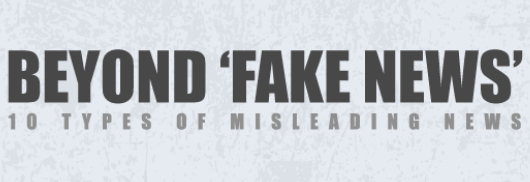Infographic: Beyond Fake News - 10 Types of Misleading News
The work needed to effectively filter information in our media-saturated environment takes time and skill. A recent study showed that the more content we consume, the more our ability to make decisions about its veracity becomes impaired. With 80% of Europeans now regularly going online, it is vital for the sustainable and effective functioning of democracy for citizens to be able to curate their media diets with a healthy critical eye.
The EAVI's Beyond Fake News infographic identifies the 10 types of potentially misleading news. It was created to be used in class with real-world examples to spark classroom debate and reflection on the ways that media is constructed.
The EAVI's Beyond Fake News infographic identifies the 10 types of potentially misleading news. It was created to be used in class with real-world examples to spark classroom debate and reflection on the ways that media is constructed.
By EAVI - Media Literacy for Citizenship
We are loath to put the term ‘fake news’ in the title of the infographic as, ironically, the term itself is a misleading simplification. Apart from the fact that the term has been co-opted to attack and silence mainstream media, the suggestion that there are simply two types of news; real and fake, doesn’t leave much room for nuance.
Below this article, you will find a pdf version of the infographic as well as a dropdown list containing some resources for teaching the 10 Types of Misleading News.
The 10 types
Of course, neither of the 10 types can be seen in isolation to the others. Partisan news outlets may also be identified as propaganda. And propaganda can be found in a sponsored post. Pseudoscience and conspiracy theories certainly enjoy each others company, see: anti-vaccination movement and climate change denialism. Likewise, completely bogus content may entice its audience with a clickbait headline. Finding examples and identifying which categories they fit into is all part of the fun of using this graphic.
The motivations
The motivations behind certain kinds of content can be many and varied. Money or power are almost always present however, there may be other motivations at play. A pseudoscientific column about climate change may be motivated by a certain ideological or political cause. However, another form of pseudoscience, health news, which some have identified as being among the most prolific in the ‘fake news’ typology, might be motivated by money or share similarities with clickbait characteristics; “The Secret Diet Your Doctor Won’t Tell You About” is a familiar refrain.
Impact levels
The impact levels are not definitive either. For instance, some students may feel that conspiracy theories are just a bit of fun, while some of us reflect that the propagation of one recent conspiracy theory led to an actual incident of violence; Pizzagate.
We hope our infographic will prompt healthy discussion. When used in conjunction with the Center for Media Literacy’s 5 media literacy concepts and questions, we believe it is a powerful way for people of any age to provoke a line of media inquiry that becomes second nature.
Some help, please!
We will endeavour to find resources with which to use and compare with the infographic but we would love it you would suggest your own to us. Especially in languages other than English.
Check out the EAVI Individual Members Group on Facebook and join so you can post examples there.
We would also love to hear your testimonials. Let us know of any successes you have had when using it, or if you think of any ways the graphic can be improved.
Translations
If you are able to translate the infographic into your mother tongue then you are an awesome person! We will credit you, of course. There is an open Google document here with the original text in English and any translations written below.
With thanks…
We must also thank EAVI’s individual members for their feedback as well as Katerina Chryssanthopoulou of the newly-formed Media Literacy Institute in Greece for her input and ideas while creating the graphic.
Fonte: EAVI Media Literacy for Citizenship (https://eavi.eu/beyond-fake-news-10-types-misleading-info/)





Comentários
Postar um comentário